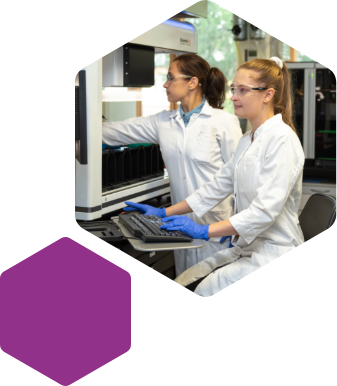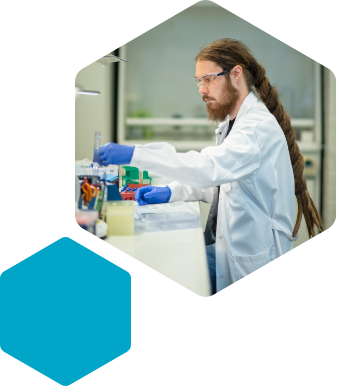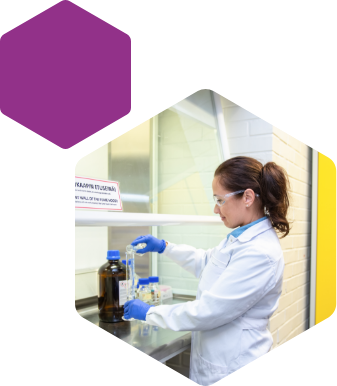Our services for Drug Interactions research
Evaluation of drug-drug interaction risk is an important part of drug safety evaluation required by the drug regulatory authorities. Both FDA and EMA guidelines for drug-drug interaction studies suggest that investigational drugs should be tested for their potential to inhibit or induce metabolic enzymes and drug transporters that are associated with clinically relevant drug-drug interactions. Additionally, the role of individual enzymes and transporters in metabolism and disposition of the investigational drugs should be characterized, in order to understand the potential for drug-drug interactions due to inhibition or induction of mechanisms dictating its pharmacokinetics.
Our services include enzyme phenotyping, clarifying the enzymes metabolizing the new chemical entity itself, and high-quality assays for inhibition and induction of CYP and UGT, as well as inhibition towards some less common metabolizing enzymes, such as FMO, MAO, CES, AOX and NAT.
CYP Inhibition
- CYP inhibition is one of the most relevant mechanisms of drug-drug interactions
- Direct inhibition using N-in-one or individual CYP assay
- Time-dependent inhibition (TDI); caused by reactive/inhibitory metabolite
- Using liver microsomes, recombinant CYP enzymes or hepatocytes
- Analysis with LC/MS/MS

Inhibition of cytochrome P450 (CYP) enzymes by a new chemical entity (NCE) may decrease the metabolism of co-medicated drugs. We offer assays for individual enzymes as well as a cocktail approach to determine inhibition towards multiple enzymes in the same incubation. Liver microsomes are recommended for high-throughput screenings and for mechanistic approach. In addition, CYP inhibition evaluation can be conducted using pooled hepatocytes.
Screening assays are performed with up to eight cytochrome P450 enzymes (1A2, 2A6, 2B6, 2C8, 2C9, 2C19, 2D6, 3A4) with nine probe reactions. Direct inhibition assay delivers IC50 values, as well as tentative Ki values towards each CYP enzyme. TDI assay results in direct and shifted IC50 values for each CYP enzyme.
More comprehensive single enzyme assays allow accurate Ki determination using multiple concentrations of a drug candidate and substrates. In the case of TDI, the assay delivers inactivation kinetic parameters maximal inactivation rate (kinact) and concentration at 50% inactivation rate (KI).
UGT Inhibition
- Screening using recombinant UGT enzymes
- Analysis with LC/MS/MS to monitor the formation of UGT-specific probe metabolites
Glucuronidation caused by uridine 5′-diphospho-glucuronosyltransferases (UGT) is an important pathway for drug metabolism in humans and other mammals. The inhibition of UGT, although less often observed than CYP inhibition, is a clinically significant form of drug-drug interactions and may lead to toxicity. Therefore, the elucidation of UGT inhibition is recommended by the regulatory authorities especially in cases where direct glucuronidation is one of the major elimination routes for the new chemical entity.
UGT inhibition assays for the isoforms UGT1A1, UGT1A3, UGT1A4, UGT1A6, UGT1A9, UGT2B7 and UGT2B15 are available using recombinant enzymes with specific substrates and several inhibitor concentrations, delivering IC50 values towards specific UGTs.
Inhibition towards other Metabolising Enzymes

Some compounds are not significantly metabolized by CYP or UGT enzymes and instead they can be metabolized by other enzymes, such as sulfotransferases (SULT), flavin containing mono-oxygenases (FMO), monoamine-oxidases (MAO), N-acetyltransferases (NAT), aldehyde oxidase (AOX) or carboxylesterases (CE). These enzymes can also be inhibited by drugs resulting in drug-drug interactions. Therefore, we offer inhibition studies towards these less common drug metabolizing enzymes as part of our drug-drug interaction services. These assays are available using recombinant enzymes with specific substrates and several inhibitor concentrations, delivering IC50 values towards specific enzymes.
CYP Induction
- Screening using pooled hepatocytes
- Regulatory compliant assay using hepatocytes from ≥3 donors
- Using mRNA and/or CYP-activity level endpoints
- Screening with PXR nuclear receptor activation
Cytochrome P450 (CYP) induction by a new chemical entity results in the increased amount and activity of relevant drug-metabolizing CYPs, which may lead to enhanced metabolism of co-medicated drugs. CYP induction is a relatively slow phenomenon due to gene regulation events, such as nuclear receptor activation and synthesis of mRNA and enzyme. Exposure times for the assays are usually 24 – 72 hours, followed by PXR activation, mRNA and/or CYP activity assessment.
As a part of our drug-drug interactions services, the CYP induction screening assays are tailored for cost-efficient simultaneous evaluation of higher number of compounds, whereas the regulatory compliant induction assay with human hepatocytes is a comprehensive package required by FDA and EMA. Each assay delivers CYP induction relative to vehicle control (x-fold) and / or EC50 values if feasible (concentration where 50% of maximal induction is achieved). The induction assays are available for CYP1A2, CYP2B6 and CYP3A4.
Assays for other CYPs or species (e.g., mouse, rat and dog) are available upon request. In addition, CYP induction can be also analyzed from tissue samples by qPCR.
UGT Induction

• Using mRNA and/or UGT-activity level endpoints
A family of uridine 5′-diphospho-glucuronosyltransferase (UGT) enzymes is the most important group of enzymes involved in conjugative drug metabolism, catalyzing addition of glucuronide acid to xenobiotics either directly or after oxidative (e.g., hydroxylation) metabolism. Interaction towards UGTs are under attention by regulatory authorities, especially in the cases where one of the major elimination pathways of the investigational drug is direct glucuronidation.
In addition to CYPs, UGT enzymes are inducible by new chemical entities. Of the inducible isoforms, UGT1A1 is the most relevant and abundant UGT enzyme. Induction assay is also available for UGT1A9 and UGT1A4 isoforms. The assays deliver UGT induction relative to vehicle control (x-fold) and / or EC50 values if feasible (concentration where 50% of maximal induction is achieved).
Transporter Interactions
Inhibition of drug transporters by a new chemical entity may alter the disposition of co-medicated drugs, resulting in significant changes in total and local drug exposures. Our drug-drug interaction services include assays for in vitro characterization of the inhibition potential of a new chemical entity towards transporters explicitly recommended in the regulatory guidance (MDR1, BCRP, OATP1B1, OATP1B3, OAT1, OAT2, and OCT2) and some additional transporters with potential clinical relevance (OCT1, MATE1 and MATE2-K). The in vitro data, with estimates on local plasma and tissue concentrations in vivo, can be used to evaluate whether further clinical investigation is advisable.
Our transporter-mediated DDI services are described in more detailed manner on Permeability and Transporters page.
